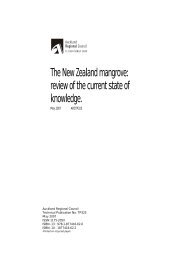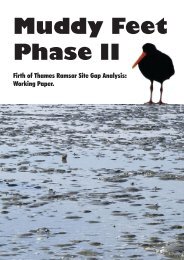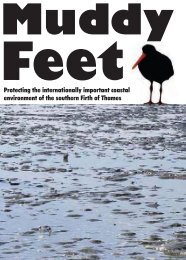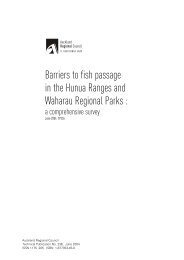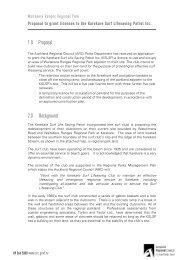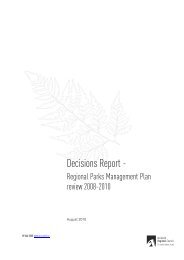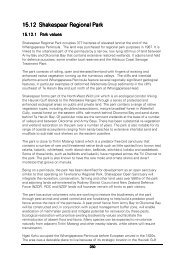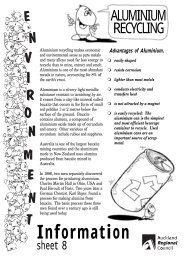archaeology and history of human occupation - Auckland Regional ...
archaeology and history of human occupation - Auckland Regional ...
archaeology and history of human occupation - Auckland Regional ...
You also want an ePaper? Increase the reach of your titles
YUMPU automatically turns print PDFs into web optimized ePapers that Google loves.
46<br />
Sometime during 1870's to 1880's or perhaps earlier, the Crown granted her 300<br />
acres including a bay originally known as Otarawao Bay which means 'haven 1 or<br />
'last refuge <strong>of</strong> shelter' - now also known as Sullivan Bay.<br />
Julia Sullivan married William Benjamin Jackson <strong>of</strong> Dublin <strong>and</strong> they toad 12<br />
children. William, variously a gum merchant, timber merchant <strong>and</strong> shipwright who<br />
lost a lot <strong>of</strong> money in the Waihi Goldmines, took possession <strong>of</strong> the l<strong>and</strong> <strong>and</strong> the<br />
family lived there permanently from the 1880's. The l<strong>and</strong> was cleared by William<br />
<strong>and</strong> his sons for farming, not an easy task <strong>and</strong> as a result two <strong>of</strong> the boys died <strong>of</strong><br />
pneumonia <strong>and</strong> consumption.<br />
A two storeyed kauri house was built but unfortunately it burnt down in 1890.<br />
Another was built, also to be used as a guest house around the turn <strong>of</strong> the century.<br />
The bottom half <strong>of</strong> this house remains in place (now the rangers residence), the top<br />
half was taken two bays north to Opahi for another family member to live in (it<br />
now belongs to the Baptist Church).<br />
Around the turn <strong>of</strong> the century Otarawao Bay was known as Jacksons Bay.<br />
However, in the early 1900's Captain William Sullivan returned to the area with a<br />
young wife <strong>and</strong> family. Finding it hard to settle, his sister Julia had a house built<br />
for them on the hill (the present Senior Ranger's house).<br />
In 1914 Julia (nee Sullivan) died followed by her husb<strong>and</strong> William Jackson in<br />
1917. Since WW I the Sullivan side <strong>of</strong> the family has looked after most <strong>of</strong> the<br />
property - Otarawao Bay by then also known as Sullivan Bay.<br />
Julia Jackson died leaving no will <strong>and</strong> as is the custom the l<strong>and</strong> passed to her eldest<br />
son, Captain John Jackson. He had little interest in the l<strong>and</strong> <strong>and</strong> sold it to his<br />
uncle, William Sullivan, for a small sum on a gentlemen's agreement. It is William<br />
Sullivan's second wife Ngarewa from which Ngarewa Drive takes its name.<br />
The Sullivans kept one end <strong>of</strong> the beach <strong>and</strong> sold the rest to the Schischkas, part <strong>of</strong><br />
which was then sold to a Mr Olsen (Perfection Textiles) <strong>and</strong> the l<strong>and</strong> passed to the<br />
„ ... ...:, Auckl<strong>and</strong> <strong>Regional</strong>Authority in 1968 at a time when applications were being made<br />
by the owner to have it zoned for urban development. Up until 1972 the l<strong>and</strong> was<br />
I leased to Mr Olsen <strong>and</strong> the Schischka. The Authority then appointed a resident<br />
1 staff member to maintain <strong>and</strong> gradually develop the l<strong>and</strong>. The last l<strong>and</strong> bought was<br />
the 15ha Tungutu block completed by 1984.<br />
Otarawao/Sullivan Bay is the site <strong>of</strong> the annual Mahurangi Regatta. The regatta<br />
was first held in 1858 <strong>and</strong> sporadically thereafter. It was revived in 1977 by The<br />
Friends <strong>of</strong> The Mahurangi Inc. <strong>and</strong> (weather permitting) it has been held each year<br />
since on the Saturday <strong>of</strong> the Auckl<strong>and</strong> Anniversary holiday weekend.<br />
Te Muri Area<br />
In 1973, the ARA acquired 120 acres at Te Muri from Mr V Schischka under the<br />
i| Public Works Act. The l<strong>and</strong> included a small cemetery which was part <strong>of</strong> Chief Te<br />
1 Hemara Tauhia's kaainga, about 120 years ago when burials began hi the late<br />
1860's. There are more than a hundred people buried in the 0.2ha graveyard<br />
|f however most <strong>of</strong> the graves are unnamed although some records <strong>of</strong> burial are<br />
available. The two pohutukawa trees are Tapu (sacred).<br />
By decree <strong>of</strong> Chief Te Hemara, European settlers could also be buried as several<br />
had married into the Maori community.<br />
;f A small wooden Anglican Church was established at Te Muri around 1872 with its<br />
i^v.,^ minister the Rev William Pomare, thought to be the first Maori ordained Minister<br />
^ 5f in New Zeal<strong>and</strong>.



